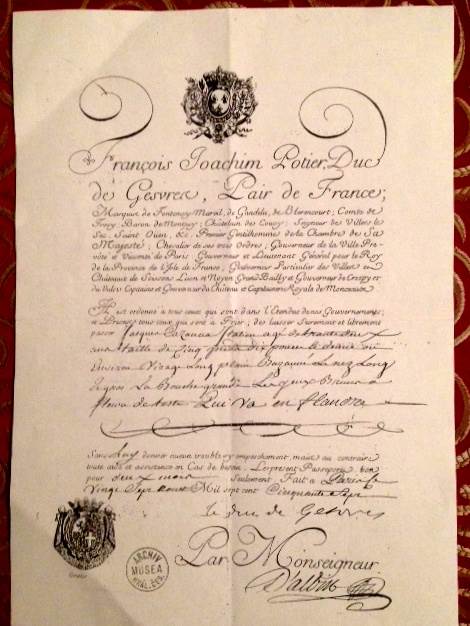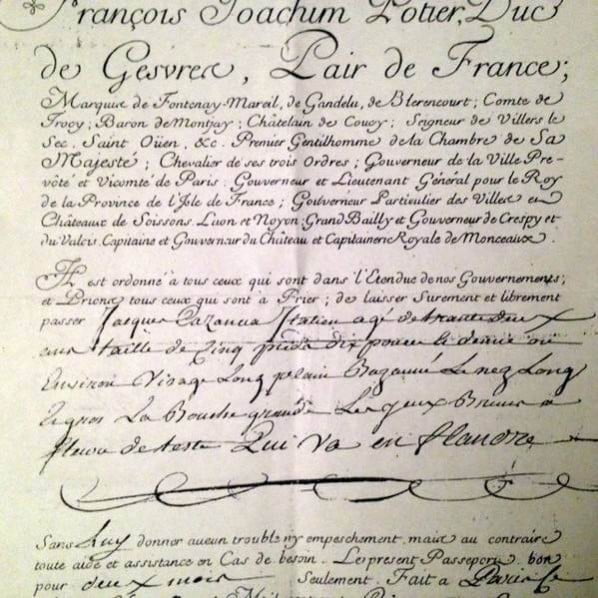Giacomo Casanova’s Passport
Look at this fantastic travel document presented by Kathleen Ann Gonzales. Her Blog SeductiveVenice follows her journey as researcher and writer about Venice, Casanova, and Gondolas. I am glad to found her great article about this outstanding passport! Kathleen gave me the permission to re-publish, which is well appreciated! Another passport article from Kathleen will follow soon.
“A passport that belonged to Casanova?! How did you get such a wonderful thing? That must be worth a fortune! I’m in complete shock. Are many of Casanova’s papers and belongings in private collections? I don’t know much about these things, but I expected them to be in museums.”
This was my reaction when my wonderful friend Marco, who likes to surprise me with gifts from across the sea, recently sent me a copy of Giacomo Casanova’s passport. I overreacted, not surprisingly, so excited at the idea that I somehow thought Marco might be sending me the actual passport! Impossible, of course!
“I forgot to type the words ‘copy of,’” he replied to me. That makes quite a difference!

Here you can see the whole page. Nowadays, we think of a passport at a little book that contains our identifying information and then visas and stamps for the places we visit. While people in the past had booklets like these, they also needed to have a larger, full-page document authorizing their travel. This one allowed Casanova to travel from France to Flanders on August 27, 1757.
Here is a close up of the middle section, where Casanova’s looks are described:

Marco had typed it out for me, but, as I don’t speak French I took it to the French teachers at the high school where I work. Ruth worked out that Casanova was 32 years old and stood at roughly 5 feet 10 1/2 inches tall. (It says “thumbs” rather than inches, but we’re guessing it’s about the same thing.) I’ve read that Casanova was an anomaly for his era at that height. He had a long, full, bronzed face, a long and large nose (as his portraits attest to), a large mouth, and brown eyes. The word “Bazanne” is an unusual choice, but we think it comes from “Basane” and refers to bronzed skin coloring. Other reports on Casanova match this. In fact, his friend the Prince de Ligne once described Casanova as having an “African tint.”
But the next line is where we ran into trouble. The line reads, “Les yeux bruns a fleure de teste.” Brown eyes and a flower head? Oops, that’s my small knowledge of Italian getting in the way of trying to translate a language I don’t speak. Ruth wasn’t sure, so we consulted Hesse, who also consulted her brother, who she said knows all sorts of small details like this. But none of them had heard this phrase before. If any of my readers out there can help us out, please write to me and let me know! By the way, the original passport is displayed in Prague, in a branch of the National Museum.
Okay, so after I posted this entry, I heard from a couple friends who shared information with me. As I mentioned below in a comment, Marco wrote to say that “a fleure de teste” means bulging eyes. Then I heard from my friend Adriano in Rome, who confirmed that definition with this forum: les yeux à fleur de tête: http://forum.wordreference.com/threads/les-yeux-%C3%A0-fleur-de-t%C3%AAte.193353/
Adriano pointed out that there are similar phrases in Italian, such as “a fior di pelle” or “a fior d’acqua.” These refer to things that are just on the surface, here meaning on the surface of the skin or water, respectively. Or this interesting idiom: “Ho i nervi a fior di pelle” means nerves on edge = I’m extremely nervous. (Adriano adds, “The interesting thing is that we normally say ‘fiore’ but in these idioms we use the short form ‘fior.’”). To connect it to the phrase on the passport, Adriano says, “In Italy we don’t say, like French people, ‘occhi a fior di testa’ = ‘eyes on the edge of the head,’ but the construction of the sentence is identical to French because the two languages are very similar.” Thanks, everyone, for sharing this information and broadening my knowledge!
Giacomo Casanova’s Passport
FAQ Passport History
Passport collection, passport renewal, old passports for sale, vintage passport, emergency passport renewal, same day passport, passport application, pasaporte passeport паспорт 护照 パスポート جواز سفر पासपोर्ट
1. What are the earliest known examples of passports, and how have they evolved?
The word "passport" came up only in the mid 15th Century. Before that, such documents were safe conducts, recommendations or protection letters. On a practical aspect, the earliest passport I have seen was from the mid 16th Century. Read more...
2. Are there any notable historical figures or personalities whose passports are highly sought after by collectors?
Every collector is doing well to define his collection focus, and yes, there are collectors looking for Celebrity passports and travel documents of historical figures like Winston Churchill, Brothers Grimm, Johann Wolfgang von Goethe. Read more...
3. How did passport designs and security features change throughout different periods in history, and what impact did these changes have on forgery prevention?
"Passports" before the 18th Century had a pure functional character. Security features were, in the best case, a watermark and a wax seal. Forgery, back then, was not an issue like it is nowadays. Only from the 1980s on, security features became a thing. A state-of-the-art passport nowadays has dozens of security features - visible and invisible. Some are known only by the security document printer itself. Read more...
4. What are some of the rarest and most valuable historical passports that have ever been sold or auctioned?
Lou Gehrig, Victor Tsoi, Marilyn Monroe, James Joyce, and Albert Einstein when it comes to the most expensive ones. Read more...
5. How do diplomatic passports differ from regular passports, and what makes them significant to collectors?
Such documents were often held by officials in high ranks, like ambassadors, consuls or special envoys. Furthermore, these travel documents are often frequently traveled. Hence, they hold a tapestry of stamps or visas. Partly from unusual places.
6. Can you provide insights into the stories behind specific historical passports that offer unique insights into past travel and migration trends?
A passport tells the story of its bearer and these stories can be everything - surprising, sad, vivid. Isabella Bird and her travels (1831-1904) or Mary Kingsley, a fearless Lady explorer.
7. What role did passports play during significant historical events, such as wartime travel restrictions or international treaties?
During war, a passport could have been a matter of life or death. Especially, when we are looking into WWII and the Holocaust. And yes, during that time, passports and similar documents were often forged to escape and save lives. Example...
8. How has the emergence of digital passports and biometric identification impacted the world of passport collecting?
Current modern passports having now often a sparkling, flashy design. This has mainly two reasons. 1. Improved security and 2. Displaying a countries' heritage, icons, and important figures or achievements. I can fully understand that those modern documents are wanted, especially by younger collectors.
9. Are there any specialized collections of passports, such as those from a specific country, era, or distinguished individuals?
Yes, the University of Western Sidney Library has e.g. a passport collection of the former prime minister Hon Edward Gough Whitlam and his wife Margaret. They are all diplomatic passports and I had the pleasure to apprise them. I hold e.g. a collection of almost all types of the German Empire passports (only 2 types are still missing). Also, my East German passport collection is quite extensive with pretty rare passport types.
10. Where can passport collectors find reliable resources and reputable sellers to expand their collection and learn more about passport history?
A good start is eBay, Delcampe, flea markets, garage or estate sales. The more significant travel documents you probably find at the classic auction houses. Sometimes I also offer documents from my archive/collection. See offers... As you are already here, you surely found a great source on the topic 😉
Other great sources are: Scottish Passports, The Nansen passport, The secret lives of diplomatic couriers
11. Is vintage passport collecting legal? What are the regulations and considerations collectors should know when acquiring historical passports?
First, it's important to stress that each country has its own laws when it comes to passports. Collecting old vintage passports for historical or educational reasons is safe and legal, or at least tolerated. More details on the legal aspects are here...
Does this article spark your curiosity about passport collecting and the history of passports? With this valuable information, you have a good basis to start your own passport collection.
Question? Contact me...

